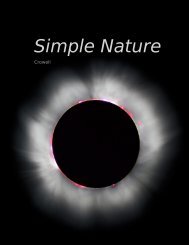The size of a radio antenna is closely related to ... - Light and Matter
The size of a radio antenna is closely related to ... - Light and Matter
The size of a radio antenna is closely related to ... - Light and Matter
You also want an ePaper? Increase the reach of your titles
YUMPU automatically turns print PDFs into web optimized ePapers that Google loves.
d / A Galilean version <strong>of</strong> the<br />
relationship between two frames<br />
<strong>of</strong> reference. As in all such<br />
graphs in th<strong>is</strong> chapter, the original<br />
coordinates, represented by the<br />
gray rectangle, have a time ax<strong>is</strong><br />
that goes <strong>to</strong> the right, <strong>and</strong> a<br />
position ax<strong>is</strong> that goes straight<br />
up.<br />
same universal laws <strong>of</strong> motion <strong>to</strong> the solar system <strong>and</strong> <strong>to</strong> the earth;<br />
th<strong>is</strong> contradicted Ar<strong>is</strong><strong>to</strong>tle, who believed that, for example, a rock<br />
would naturally want <strong>to</strong> move in a certain special direction (down)<br />
in order <strong>to</strong> reach a certain special location (the earth’s surface).<br />
Property 3 <strong>is</strong> the reason that Einstein called h<strong>is</strong> theory “relativity,”<br />
but Galileo <strong>and</strong> New<strong>to</strong>n believed exactly the same thing <strong>to</strong> be true,<br />
as dramatized by Galileo’s run-in with the Church over the question<br />
<strong>of</strong> whether the earth could really be in motion around the sun.<br />
Property 4 would probably surpr<strong>is</strong>e most people only because it<br />
asserts in such a weak <strong>and</strong> specialized way something that they feel<br />
deeply must be true. <strong>The</strong> only really strange item on the l<strong>is</strong>t <strong>is</strong> 5,<br />
but the Hafele-Keating experiment forces it upon us.<br />
If it were not for property 5, we could imagine that figure d<br />
would give the correct transformation between frames <strong>of</strong> reference<br />
in motion relative <strong>to</strong> one another. Let’s say that observer 1, whose<br />
grid coincides with the gray rectangle, <strong>is</strong> a hitch-hiker st<strong>and</strong>ing by<br />
the side <strong>of</strong> a road. Event A <strong>is</strong> a raindrop hitting h<strong>is</strong> head, <strong>and</strong><br />
event B <strong>is</strong> another raindrop hitting h<strong>is</strong> head. He says that A <strong>and</strong> B<br />
occur at the same location in space. Observer 2 <strong>is</strong> a mo<strong>to</strong>r<strong>is</strong>t who<br />
drives by without s<strong>to</strong>pping; <strong>to</strong> him, the passenger compartment <strong>of</strong><br />
h<strong>is</strong> car <strong>is</strong> at rest, while the asphalt slides by underneath. He says<br />
that A <strong>and</strong> B occur at different points in space, because during the<br />
time between the first raindrop <strong>and</strong> the second, the hitch-hiker has<br />
moved backward. On the other h<strong>and</strong>, observer 2 says that events A<br />
<strong>and</strong> C occur in the same place, while the hitch-hiker d<strong>is</strong>agrees. <strong>The</strong><br />
slope <strong>of</strong> the grid-lines <strong>is</strong> simply the velocity <strong>of</strong> the relative motion<br />
<strong>of</strong> each observer relative <strong>to</strong> the other.<br />
Figure d has familiar, comforting, <strong>and</strong> eminently sensible behavior,<br />
but it also happens <strong>to</strong> be wrong, because it violates property<br />
5. <strong>The</strong> d<strong>is</strong><strong>to</strong>rtion <strong>of</strong> the coordinate grid has only moved the vertical<br />
lines up <strong>and</strong> down, so both observers agree that events like B <strong>and</strong><br />
C are simultaneous. If th<strong>is</strong> was really the way things worked, then<br />
all observers could synchronize all their clocks with one another for<br />
once <strong>and</strong> for all, <strong>and</strong> the clocks would never get out <strong>of</strong> sync. Th<strong>is</strong><br />
contradicts the results <strong>of</strong> the Hafele-Keating experiment, in which<br />
all three clocks were initially synchronized in Washing<strong>to</strong>n, but later<br />
went out <strong>of</strong> sync because <strong>of</strong> their different states <strong>of</strong> motion.<br />
It might seem as though we still had a huge amount <strong>of</strong> wiggle<br />
room available for the correct form <strong>of</strong> the d<strong>is</strong><strong>to</strong>rtion. It turns out,<br />
however, that properties 1-5 are sufficient <strong>to</strong> prove that there <strong>is</strong> only<br />
one answer, which <strong>is</strong> the one found by Einstein in 1905. To see why<br />
th<strong>is</strong> <strong>is</strong>, let’s work by a process <strong>of</strong> elimination.<br />
Figure e shows a transformation that might seem at first glance<br />
<strong>to</strong> be as good a c<strong>and</strong>idate as any other, but it violates property<br />
3, that motion <strong>is</strong> relative, for the following reason. In observer 2’s<br />
frame <strong>of</strong> reference, some <strong>of</strong> the grid lines cross one another. Th<strong>is</strong><br />
386 Chapter 7 Relativity














